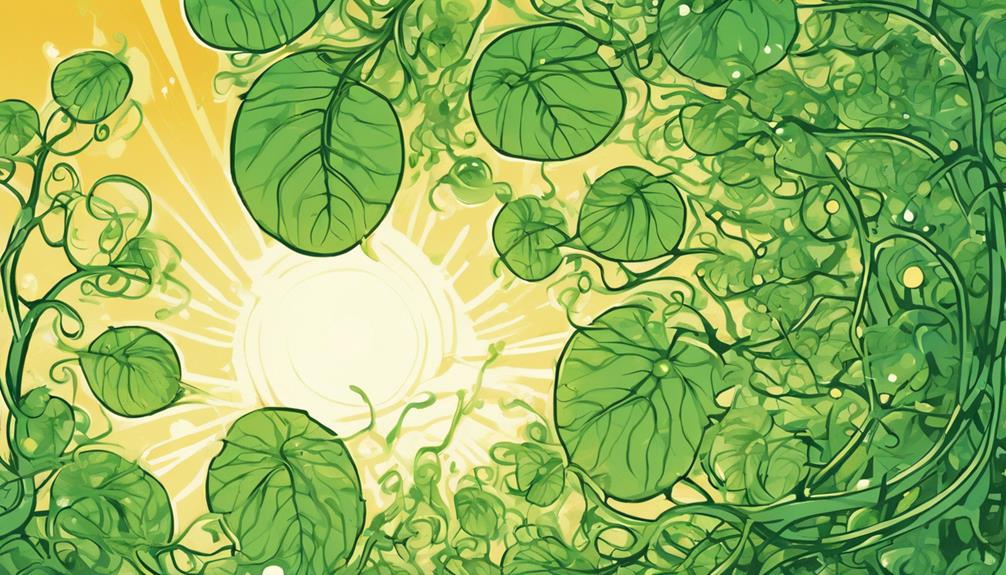You're likely unaware that the biotic component responsible for trapping solar energy is found in the cells of green plants, specifically in organelles called chloroplasts, which contain the pigment chlorophyll. Chlorophyll captures sunlight and converts it into chemical energy through photosynthesis, storing it in the form of glucose. This energy is then transferred to other organisms in the food chain. Without chlorophyll, plants can't survive, and life on Earth would be vastly different. As you explore the intricacies of solar energy trapping, you'll uncover the crucial role it plays in sustaining life and ecosystem balance.
Key Takeaways
- Green plants are the biotic component that can trap solar energy through the process of photosynthesis.
- Chloroplasts in green plants absorb sunlight, and chlorophyll pigment converts it into chemical energy.
- Chlorophyll captures light energy to power photosynthesis, initiating the process of solar energy conversion.
- Solar energy is trapped in the form of glucose, which is the chemical energy stored in green plants.
- Leaves play a crucial role in solar energy absorption, as they contain chloroplasts that facilitate the energy trapping process.
The Ultimate Source of Energy
You likely are aware that virtually everything on our planet relies on one fundamental source of power: solar energy. This ultimate source of energy is the driving force behind almost all living processes. Without it, life as we understand it wouldn't exist.
But have you ever stopped to think about how this energy is harnessed? The answer lies in the process of photosynthesis, where green plants convert solar energy into chemical energy. This chemical energy is then stored in the form of glucose, which is used to fuel growth and development.
As the primary producers of our ecosystem, green plants play a vital role in trapping solar energy and converting it into a usable form. This energy is then passed on to other organisms, either directly or indirectly, through the food chain.
Essentially, solar energy is the spark that sets the wheel of life in motion. Without it, our ecosystem would come to a grinding halt.
Trapping Solar Energy Process
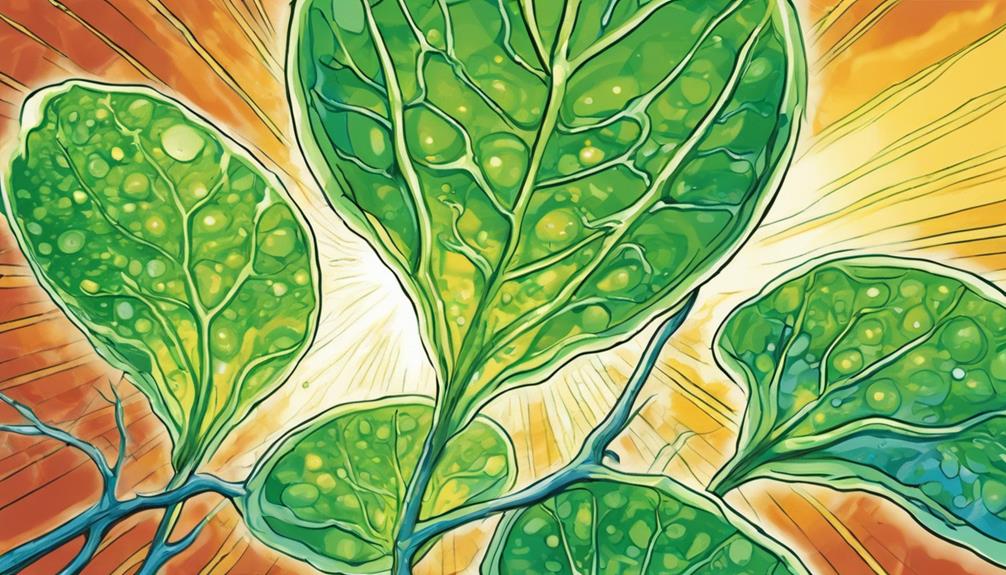
As you explore the trapping solar energy process, you'll discover that it all starts with the absorption of solar energy.
You'll learn how chlorophyll, an essential pigment found in chloroplasts, plays a pivotal role in this process.
Solar Energy Absorption
During photosynthesis, chloroplasts in green plants absorb sunlight, harnessing its energy through the pigment chlorophyll to fuel their growth and development. As you explore the process, you'll discover that these tiny organelles are responsible for capturing solar energy.
The energy from the sun is what drives photosynthesis, allowing plants to produce glucose and oxygen. Without this intake of solar energy, plants wouldn't be able to survive.
You might wonder how plants manage to trap this energy. The answer lies in their leaves, which play an essential role in solar energy absorption. The chloroplasts within these leaves contain pigments like chlorophyll, which absorbs sunlight and converts it into chemical energy.
This energy is then used to power the process of photosynthesis, producing the glucose and oxygen that plants need to thrive. As you explore further into the world of photosynthesis, you'll realize that solar energy absorption is the crucial first step in this process.
Without it, plants wouldn't be able to harness the energy they need to grow and develop.
Chlorophyll's Crucial Role
One pigment stands out for its essential role in trapping solar energy: chlorophyll, a green pigment found in chloroplasts. You might wonder why chlorophyll is so important, and the answer lies in its ability to absorb sunlight and convert it into chemical energy. Without chlorophyll, green plants wouldn't be able to harness solar energy, which is necessary for their survival and growth.
Chlorophyll plays a key role in the process of photosynthesis by capturing solar energy and using it to produce food for plants. This pigment is responsible for absorbing sunlight and converting it into a usable form of energy. In other words, chlorophyll is the biotic component that enables plants to trap solar energy and use it to fuel their growth and development.
As you can see, chlorophyll's role in trapping solar energy is essential. Without it, plants wouldn't be able to produce the energy they need to survive. Chlorophyll's ability to absorb and convert solar energy makes it an indispensable component of the photosynthetic process.
Role of Solar Energy in Food Chain
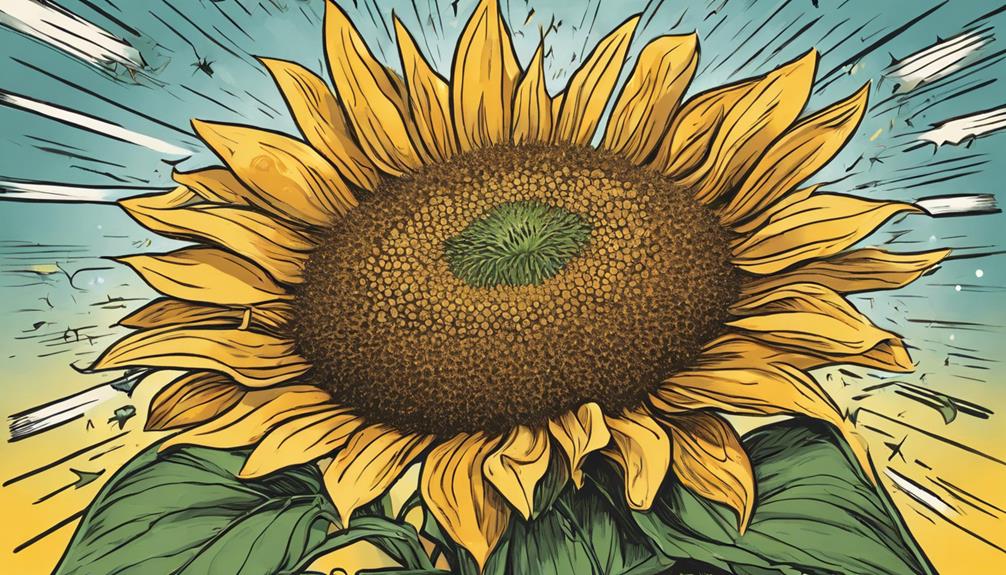
You rely on solar energy to power your life, even if you aren't aware of it, because it's the driving force behind the food chain. Green plants, the primary producers, convert solar energy into chemical energy through photosynthesis. This energy is then transferred to herbivores when they consume these plants, and subsequently to carnivores when they consume the herbivores.
Here's how solar energy impacts the food chain:
- Solar energy is the ultimate source of energy for the food chain.
- Green plants, such as phytoplankton, algae, and trees, convert solar energy into chemical energy.
- Herbivores, like deer and rabbits, rely on green plants as their primary source of energy.
- Carnivores, such as lions and wolves, obtain energy by consuming herbivores.
- The energy transfer in the food chain is unidirectional, with solar energy driving the entire process.
In essence, solar energy sustains all levels of the food chain, highlighting its critical role in ecosystem dynamics. Without it, life as understood wouldn't be possible.
Efficiency of Solar Energy Capture
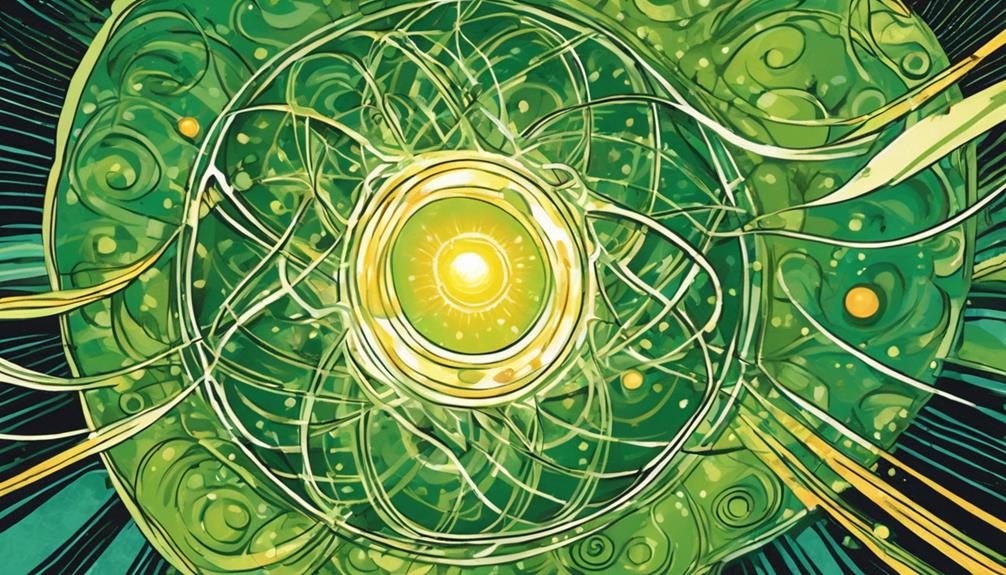
As you explore the role of solar energy in the food chain, it's evident that green plants stand out as biotic components that efficiently trap solar energy using their leaves. But how effective is this process, really? The truth is, only a fraction of solar energy is transferred to higher trophic levels in ecosystems. This means that a significant amount of energy is lost at each trophic level, showcasing the efficiency of solar energy capture by green plants.
Energy pyramids demonstrate this decrease in energy as it moves up the food chain from solar energy. This visualization highlights the vital role that green plants play in capturing solar energy, which is then transferred to other organisms.
The efficiency of solar energy capture is what maintains ecosystem balance, allowing energy to flow from one level to the next. You can see that the efficiency of solar energy capture is what makes life on Earth possible. Without this process, energy wouldn't be able to flow through ecosystems, and life as we're aware of it wouldn't exist.
Importance of Photosynthesis in Ecosystems

By converting solar energy into chemical energy, photosynthesis empowers green plants to thrive, ultimately sustaining life in ecosystems. As you explore the significance of photosynthesis, you'll realize that it's the backbone of ecosystems. Without it, life as it stands wouldn't exist.
Here are some key reasons why photosynthesis is vital:
- Oxygen release: Photosynthesis produces oxygen as a byproduct, which is essential for the survival of most living organisms.
- Foundation of the food chain: Photosynthesis is the primary source of energy for green plants, which are the producers of the ecosystem, providing food for herbivores and omnivores.
- Energy conversion: Photosynthesis converts solar energy into chemical energy, which is then stored in the form of glucose, providing energy for plant growth and development.
- Ecosystem balance: Photosynthesis helps maintain the balance of the ecosystem by regulating the levels of oxygen and carbon dioxide.
- Food production: Photosynthesis enables green plants to produce their own food, making them self-sufficient and supporting the entire food chain.
In essence, photosynthesis is the unsung hero of ecosystems, and its importance can't be overstressed.
Key Players in Solar Energy Conversion
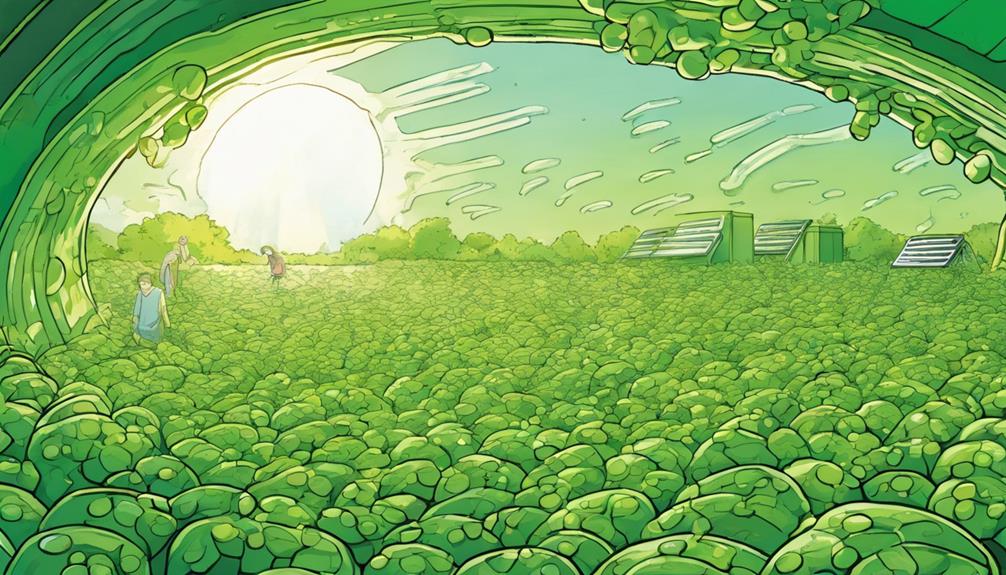
As you explore the key players in solar energy conversion, you'll find that chloroplasts take center stage.
You'll discover how these tiny organelles, found in plant cells, harness the sun's energy to fuel photosynthesis.
You'll also learn about the vital roles of green pigment absorption and plant cell photosynthesis in this process.
Chloroplast's Role
You'll find that chloroplasts, tiny organelles within green plant parts, are the biotic components responsible for trapping solar energy for photosynthesis. These tiny powerhouses contain the essential chlorophyll pigment, which absorbs sunlight energy and converts it into chemical energy. This energy is then used to fuel plant growth and survival.
Here are some key facts about chloroplasts and their role in trapping solar energy:
- Chloroplasts are plastids found in green plant parts that trap solar energy for photosynthesis.
- They convert solar energy into chemical energy, essential for plant growth and survival.
- The process of photosynthesis occurs in chloroplasts, where solar energy is harnessed to produce glucose.
- Chloroplasts play a key role in converting solar energy into usable energy for plants through the photosynthetic process.
- Without chloroplasts, plants wouldn't be able to undergo photosynthesis, and life on Earth would be vastly different.
Green Pigment Absorption
Chlorophyll, the green pigment within chloroplasts, takes center stage in trapping solar energy, converting it into chemical energy that fuels plant growth and sustains ecosystem functioning.
As you explore the world of green plants, you'll discover that chlorophyll is the key player in absorbing sunlight. This green pigment is responsible for capturing light energy, which is then used to power photosynthesis. Without chlorophyll, plants wouldn't be able to convert solar energy into glucose, their primary source of energy.
When light energy hits chlorophyll molecules, they absorb it, initiating the photosynthetic process. This absorption is essential for the efficient conversion of solar energy into chemical energy. Chlorophyll's unique molecular structure allows it to capture specific wavelengths of light, making it an ideal pigment for photosynthesis.
As you investigate further into the world of green plants, you'll realize that chlorophyll is the unsung hero behind their ability to thrive. Its ability to trap solar energy is what makes life on Earth possible, and it's what sets green plants apart from other living organisms.
Plant Cell Photosynthesis
How do tiny plant cells manage to capture and convert solar energy into life-sustaining chemical bonds, and what key players make this process possible?
The answer lies in plant cell photosynthesis, where chloroplasts play an essential role. These tiny organelles, found in plant cells, algae, and some bacteria, are responsible for trapping solar energy for photosynthesis.
Here's how they make it happen:
- Chloroplasts contain chlorophyll, a green pigment that absorbs light energy essential for solar energy conversion.
- Chloroplasts are where photosynthesis takes place, converting solar energy into chemical energy for plants.
- Chloroplasts are present in green plants, algae, and some bacteria, enabling them to capture and convert solar energy.
- The process of photosynthesis in plant cells relies on chloroplasts to harness and transform solar energy efficiently.
- Chloroplasts are the powerhouse of plant cells, allowing them to thrive and sustain life.
In short, chloroplasts are the unsung heroes of plant cell photosynthesis, making it possible for plants to convert solar energy into life-sustaining chemical bonds.
Solar Energy's Impact on Ecosystem Balance

As the primary source of energy for nearly all ecosystems, solar energy's influence on ecosystem balance is intricate and far-reaching. You might wonder how it affects the delicate balance of ecosystems. The answer lies in green plants, also known as producers, which trap solar energy through photosynthesis, converting it into chemical energy. This energy is then used to fuel their growth and development.
As a result, you see a ripple effect throughout the ecosystem. The efficient capture of solar energy by green plants sustains all levels of the food chain, from herbivores to carnivores. This unidirectional transfer of energy from the sun to producers to consumers regulates the ecosystem's stability.
Without solar energy, ecosystems would collapse, and life as you know it would cease to exist. So, the next time you see a green plant, remember its vital role in maintaining ecosystem balance by harnessing solar energy. This intricate relationship is what keeps ecosystems thriving, and it's crucial to appreciate the significance of solar energy's impact on ecosystem balance.
Frequently Asked Questions
What Is Used to Trap Solar Energy?
You're wondering what's used to trap solar energy? Well, it's chlorophyll, a green pigment in chloroplasts within plant cells, that absorbs light energy to initiate photosynthesis, converting it into chemical energy for plant growth and survival.
How Can We Trap Solar Energy?
You can trap solar energy by mimicking nature's way, using photovoltaic cells or solar panels that convert sunlight into electricity, or even harnessing it through bio-inspired technologies that replicate chlorophyll's energy-absorbing properties.
How Is Solar Energy Captured in the Biosphere?
You're wondering how solar energy is captured in the biosphere. Well, it's through photosynthesis, where green plants, like you're probably aware, convert sunlight into chemical energy, storing it as glucose, which fuels life and maintains ecosystem harmony.
Which Pigment Traps Solar Energy?
You're the master gardener, cultivating life, and you know that chlorophyll, the green gold, is the pigment that traps solar energy, absorbing blue and red wavelengths to fuel photosynthesis, making your plants thrive.
How Does Energy Conservation Connect to the Biotic Component that Traps Solar Energy?
Energy conservation plays a vital energy conservation role in the biotic component that traps solar energy. By reducing energy consumption, organisms can better utilize and store solar energy for their metabolic processes. This helps sustain the delicate balance of the ecosystem and ensures the efficient use of solar energy by living organisms.
Conclusion
As you stand amidst the vibrant tapestry of life, remember that you're woven into an intricate web of energy, with solar energy as the golden thread. It's the spark that ignites the fire of photosynthesis, powering the very fabric of our ecosystem.
Without it, the delicate balance would unravel, leaving behind a desolate landscape. So, bask in the warmth of this radiant energy, and reverence the leafy guardians that harness its power, for they're the unsung heroes that sustain life on earth.
